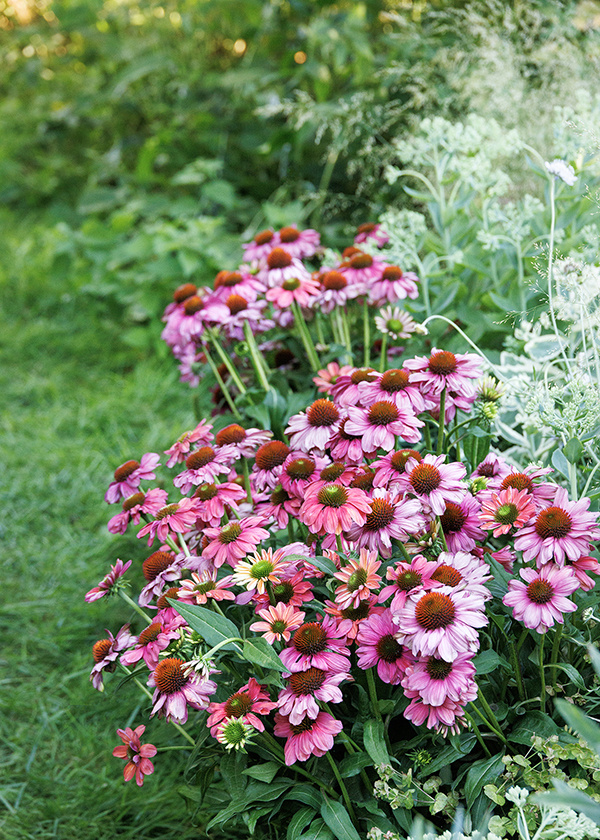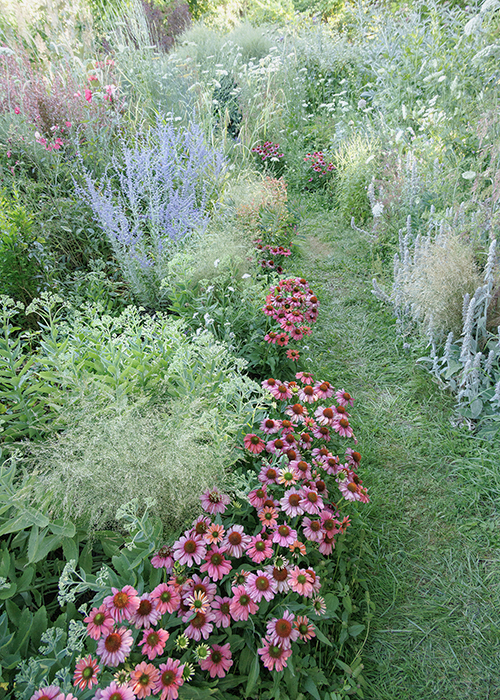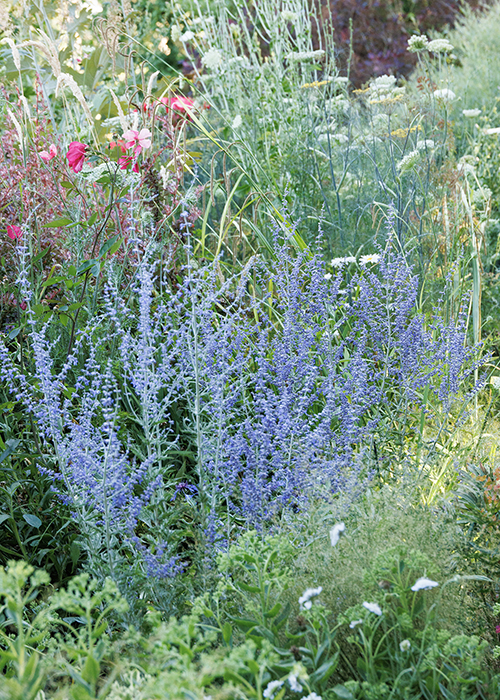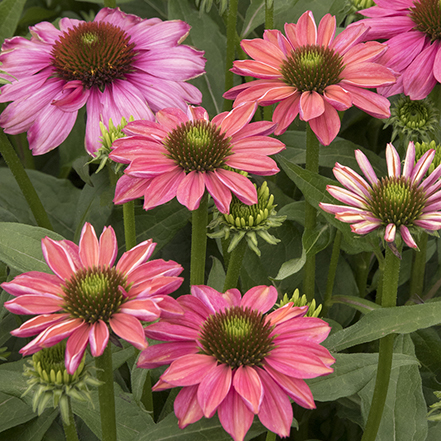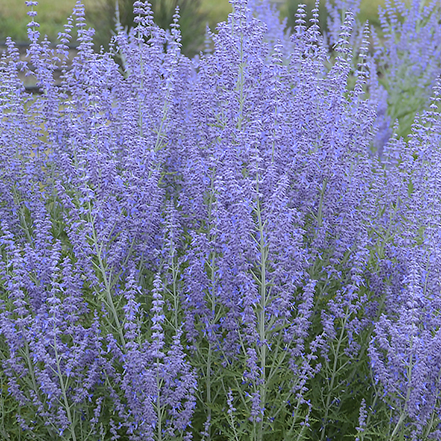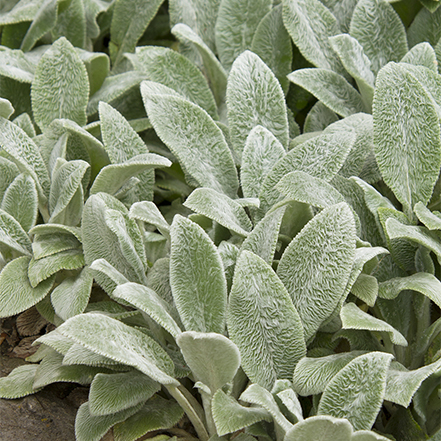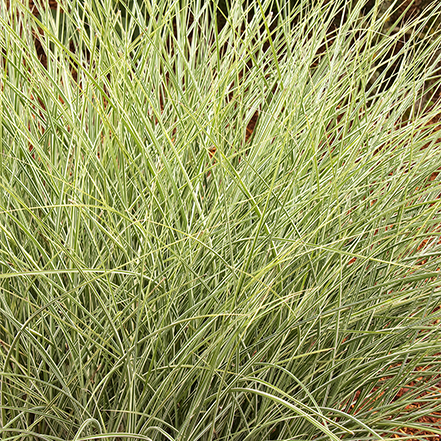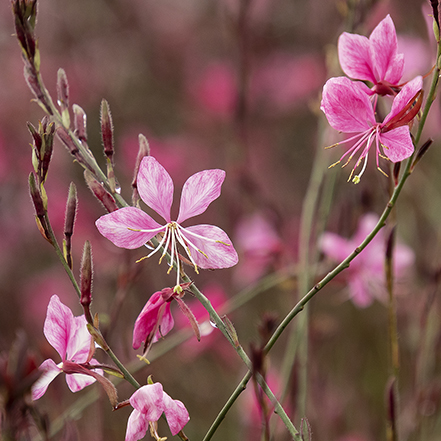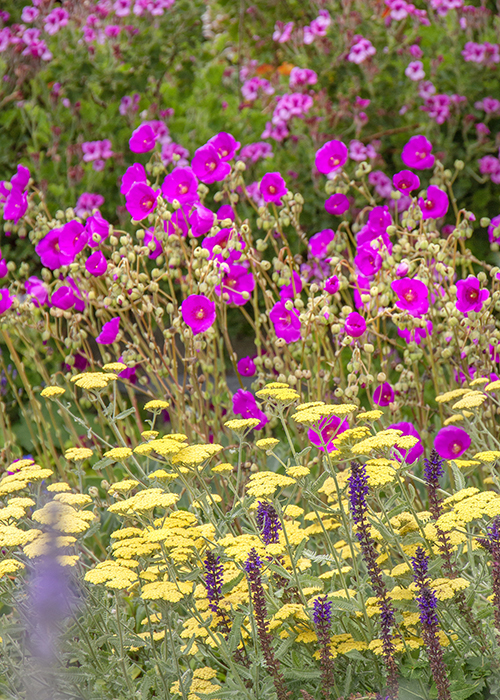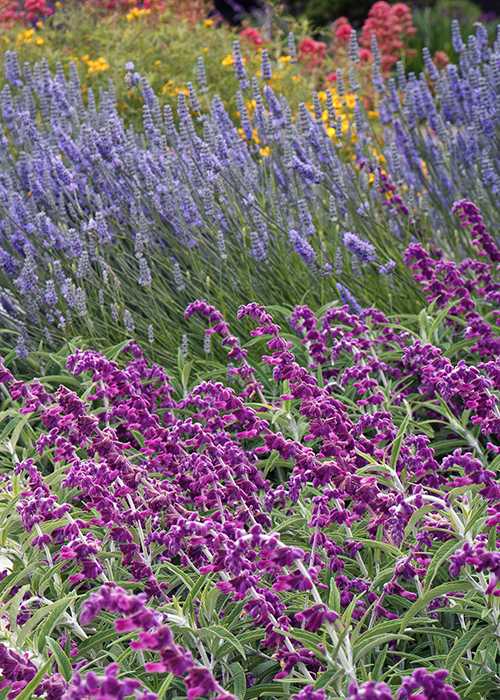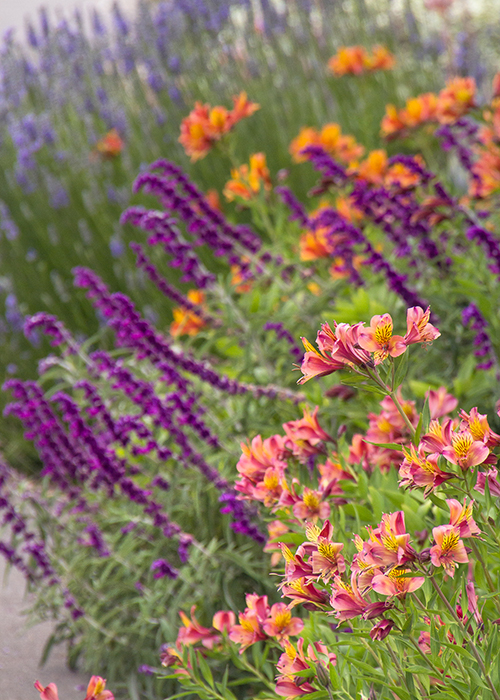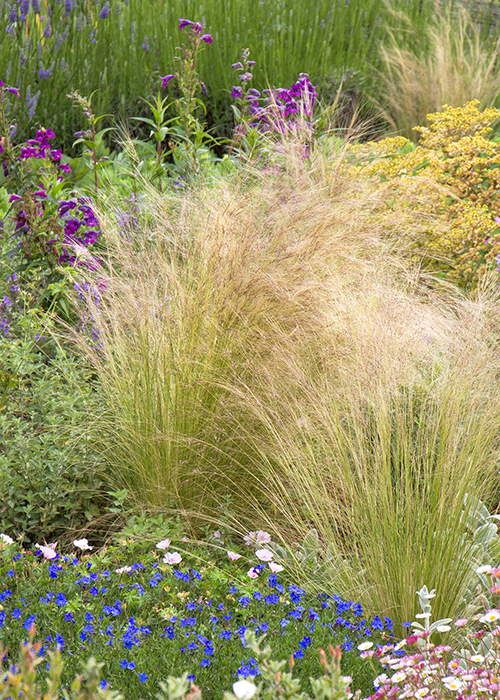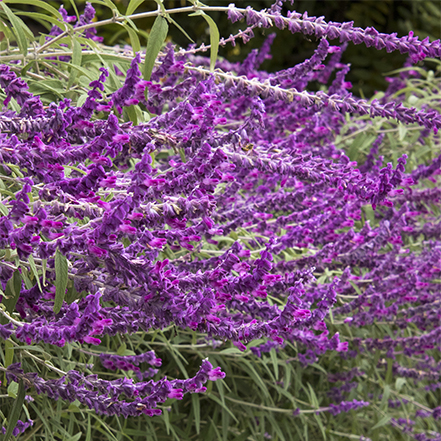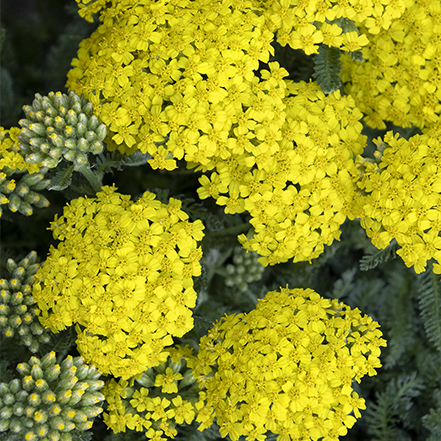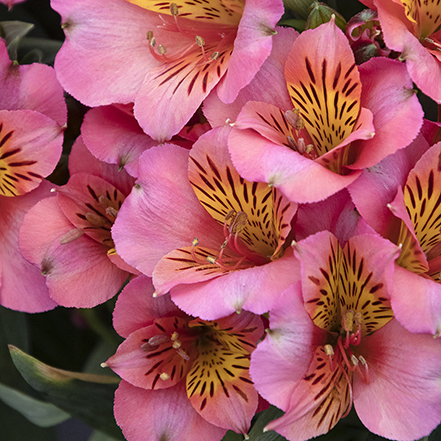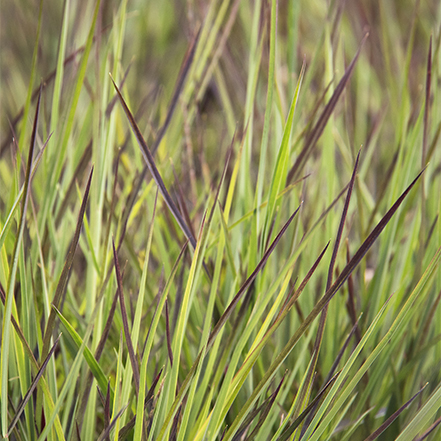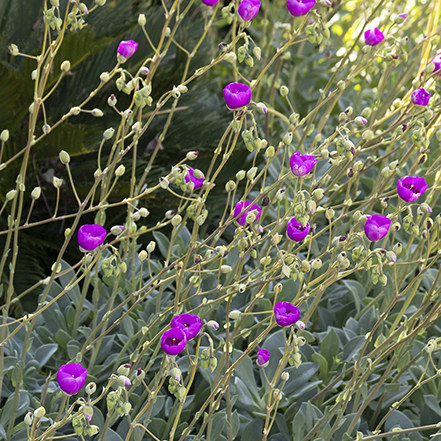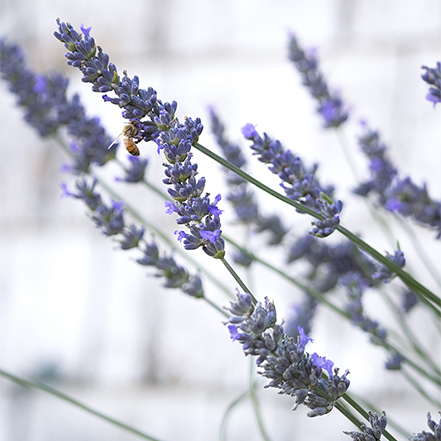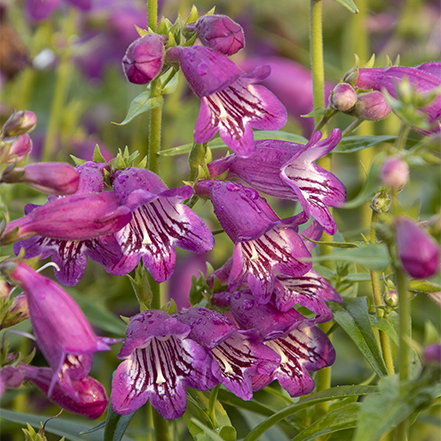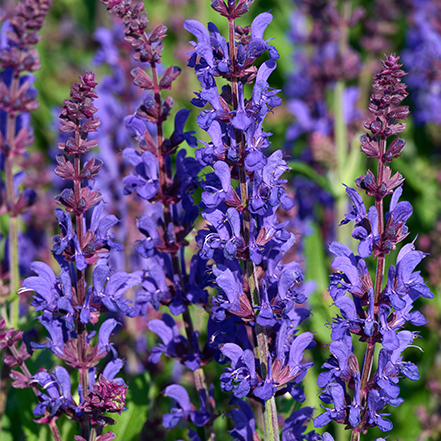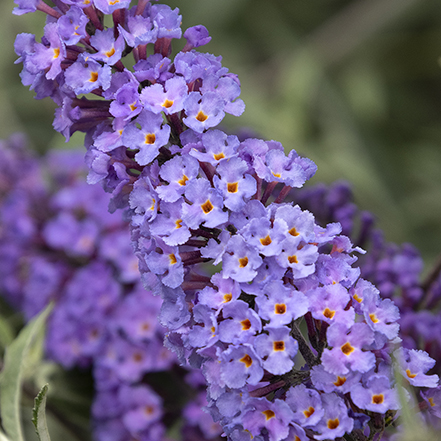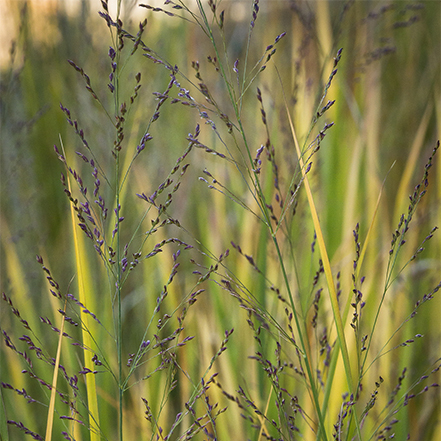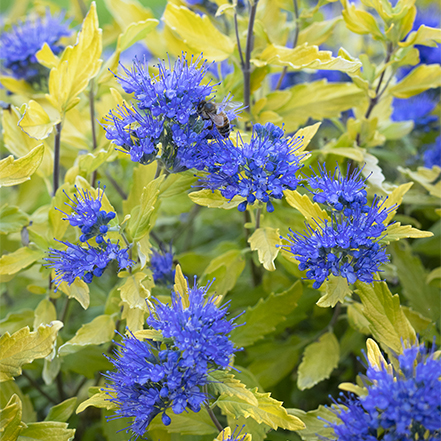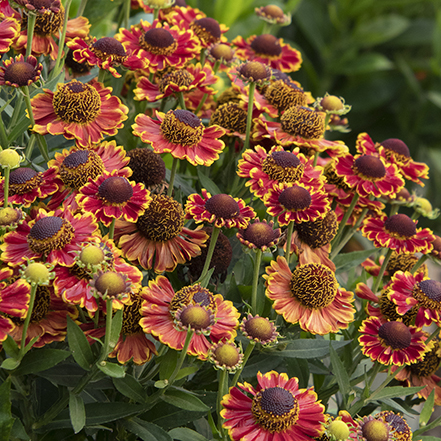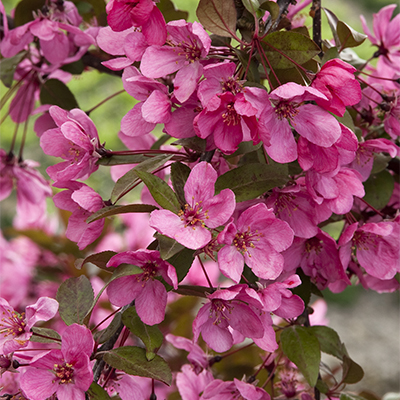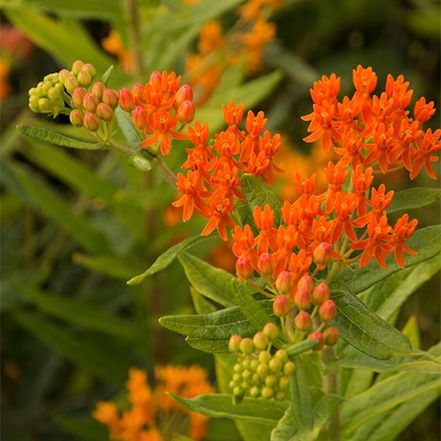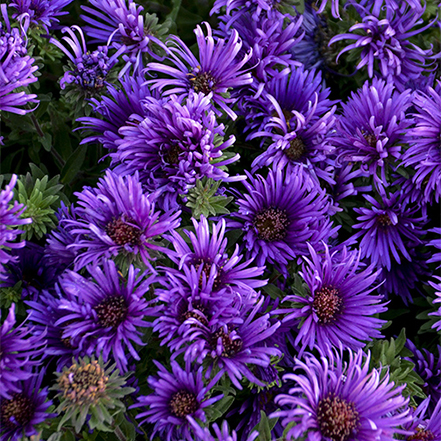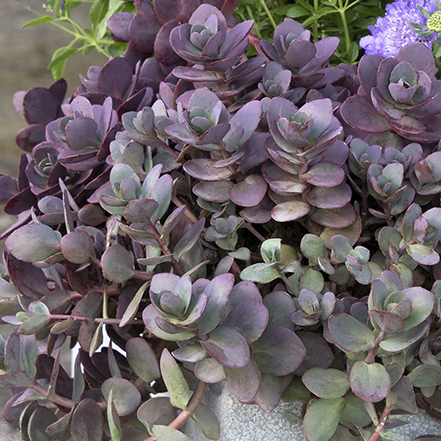Join us in this "Design School" lesson as we delve into the fascinating world of pollinator garden design, exploring three distinct styles that not only attract and support essential pollinators but also elevate the appeal of your outdoor space. From the enchanting charm of a lush cottage garden to the curated color and form of a contemporary design, each style offers a unique approach to creating a pollinator-friendly haven.
Discover how you can infuse your garden with beauty, biodiversity, and ecological value while showcasing your personal style and contributing to the well-being of our pollinator friends. Get inspired as we explore these three captivating pollinator garden design styles and provide practical tips and plant recommendations to bring your vision to life.
Pollinator Garden Style: Dreamy Cottage Garden
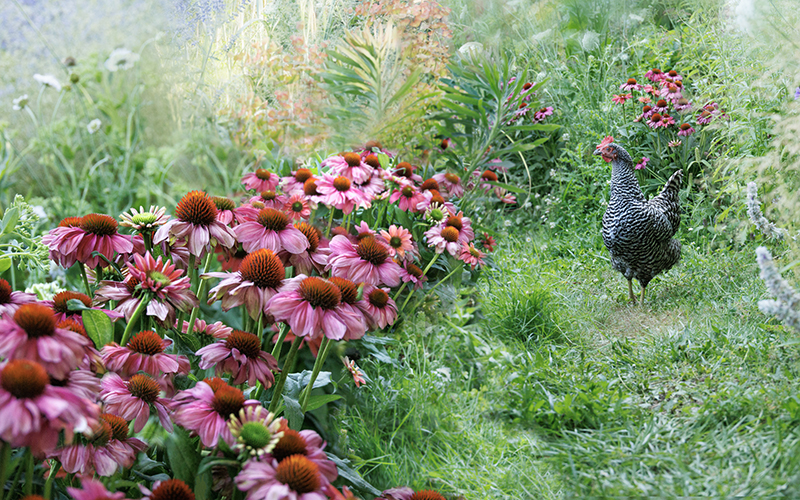
This wild and wonderful garden is full of life, including chickens, cats, bees, butterflies, hummingbirds, and of course, human friends and family, too! The pink Evolution™ Colorific™ Coneflowers are the showstoppers along this meadow pathway, drawing the eye around the bend with dynamic pinks and greens.
If you are drawn to the look of this enchanting garden and love to feel transported to a magical place of floating butterflies, glimmering sunlight, and an ethereal aesthetic, this dreamy pollinator garden style is for you.
If the tapestry of textures and a touch of the wild calls to you, then don't hold back! Here are a few tips for achieving this meadow-inspired pollinator garden in your own backyard.
5 Tips for Creating a Dreamy Pollinator Garden
1. A little bit of wildness goes a long way. Mix wildflowers, ornamental grasses, and reliable long-blooming performers like Evolution™ Coneflowers to provide a tapestry of textures as well as lasting nectar for pollinators.
2. Look for plants that bloom in airy spikes, fluttering petals, and lofty wands to give a delicate aesthetic to your hardy meadow planting. Agastache, Russian sage, catmint, guara, and liatris are all great examples of hardy plants that have airy appeal.
3. Opt for blooms in soft colors like lavender, light pink, periwinkle blue, and white. Muted tones are soothing to the eye, and when combined, offer a gorgeous palette that is colorful yet tranquil. Cottage classics like lavender, daisies, pink, peach, or white roses, and agapanthus are all great choices for this color palette.
4. Play with light. Choose silvery foliage that glitters in the sun, and billowing grasses with seedheads or plumes that shine when backlit at sunrise or sunset. Lamb's ear, Blonde Ambition blue grama grass, pink muhly grass, and Artemesia are wonderful examples of habitat-friendly plants that are enhanced with the right lighting.
5. Encourage exploration. Remember to make room for pathways, magic moments, and surprises along the way. Gardens—large or small—are meant to be enjoyed, so invite exploration with easy accessibility.
Get the Look with These Pollinator-Friendly Plants
Evolution™ Colorific™
Coneflower
A bright green cone at the center of every bloom, framed by dense petals in a lovely palette of pink hues. Lush foliage and sturdy, upright stems create a beautiful backdrop for the continuous profusion of blooms from late spring through fall. Full sun. Up to 20" tall, 18" wide. Zones 4-9.
Blue Jean Baby
Russian Sage
A shorter, compact variety with upright stems that resist flopping. Midsummer lavender-blue flowers and smoky purple calyxes that hold well into fall. Finely textured aromatic foliage is a complementary soft gray-green. Full sun. Up to 3' tall, 3' wide. Zones 4-9.
Silver Carpet
Lamb's Ears
An improved selection over the original garden favorite with dense, silver-white, woolly foliage. An excellent low-maintenance option for edging a path, or as a low border planting. Up to 12" tall, gradually spreading to form a dense mat. Partial to full sun. Zones 4-8.
Dwarf Joe
Pye Weed
A compact Joe Pye Weed with showy, mauve-purple, dome-shaped flower heads provides spectacular late summer color and vertical interest in borders and naturalized areas. A wonderful addition to meadows, pollinator gardens, and stream margins. Partial shade to partial sun. Up to 4' tall, 3' wide. Zones 4-9.
Morning Light
Maiden Grass
Dense clumps of slender, green blades with creamy white margins and midveins create a shimmering silvery appearance. A superb sterile grass that adds visual excitement wherever used. Partial to full sun. Up 5' tall, 4' wide; plumes reach 6' tall. Zones 5-9.
Steffi™ Deep
Rose Gaura
A rounded form with robust foliage and an abundance of upright spikes blanketed with dark rose-pink flowers that provide vibrant seasonal color from late spring through early fall. Excellent heat and drought tolerance. Full sun. Up to 24" tall and wide. Zones 5-9.
Pollinator Garden Style: Lively Layers
These vibrant pollinator garden plantings are energizing, creative, and playful. Bright pinks and purples are combined with complementary colors like yellow and orange to charge the whole space with a lively style that draws in pollinators and plant lovers alike.
If you love a colorful garden full of bright blooms that make you feel alive and inspired, this style is for you. Find five tips for creating your own lively, layered garden full of bees, butterflies, hummingbirds, and colors below.
5 Tips for Creating a Lively Pollinator Garden
1. Select a vibrant color palette. Choose a diverse range of flowering plants with vibrant colors to attract pollinators. Opt for a mix of warm hues like red, orange, and yellow, as well as cool tones like purple and blue. Warm-toned pollinator plants include agastache, red hot poker, yarrow, black-eyed Susan, and blanket flower. Complementary cool-toned pollinator plants include salvia, catmint, lavender, and penstemon. This variety will not only create a visually stunning garden but also appeal to different pollinator species.
2 . Think in layers. Design your garden with layers of plants to provide different heights and textures. Pay attention to mature plant size and arrange your plants in height from high to low, with the tallest at the back and the shortest in the front.
3. Plan for your favorite color combinations. Pair plants with complementary or contrasting hues and similar bloom times to create eye-catching displays throughout the season. Experiment with different color schemes to find the combinations that resonate with you.
4. Consider seasonal color and interest. Plan your garden to have interest throughout the year by selecting plants with varied seasonal characteristics. Look for plants with colorful foliage, interesting bark, or berries that persist into the colder months. This ensures that your garden remains appealing to you (and to local birds) even when flowers are not in bloom.
5. Plant en masse. Also known as "mass(ed) planting" and "planting in drifts," planting en masse means filling a space with several of the same type of plant. Not only does a massed planting make a big visual impact, but it is also the best way to offer easy foraging for pollinators.
Get the Look with These Pollinator-Friendly Plants
Santa Barbara
Mexican Bush Sage
A more compact selection of the beloved Mexican bush sage with the same rich-purple flowers and long bloom season. Ssoft, gray-green foliage is a wonderful complement to the bright blooms. Full sun. Up to 3' tall and wide. Zones 9-11.
Desert Eve™
Yellow Yarrow
A compact, early-blooming, variety with lemon-yellow flowers held above ferny foliage. The dried seedheads feed overwintering birds. Heat-loving, pollinator-friendly, waterwise, and seldom grazed by deer. Full sun. Up to 18" tall and wide. Zones 4-9.
Colorita® Eliane®
Peruvian Lily
Masses of large, pink petals with a golden center and rich maroon flecks bloom from early spring to first frost. Rhizomes survive underground after moderate frost, producing strongly branched flower stems in spring. Partial to full sun. Up to 12" tall and wide. Zones 8-11 (or grow as annual).
Blue Heaven
Little Bluestem
Upright foliage creates a great vertical accent for pollinator- and bird-friendly gardens. Emerges blue, develops into pink and burgundy in late summer, and turns copper in fall. Slender stems rise up with purplish panicles. Full sun. Up to 4' tall, 3' wide. Zones 3-10.
Shining Pink
Rock Purslane
Hot-pink, flowers dance above fleshy blue-green rosettes from spring until first frost. This sturdy plant thrives in heat and drought when established, blooming nearly year-round in warm, frost-free regions. A handsome succulent that will infuse vibrant color and draw bees to pollinator plantings. Full sun. Up to 12" tall and wide. Zones 9-11 (or grow as annual).
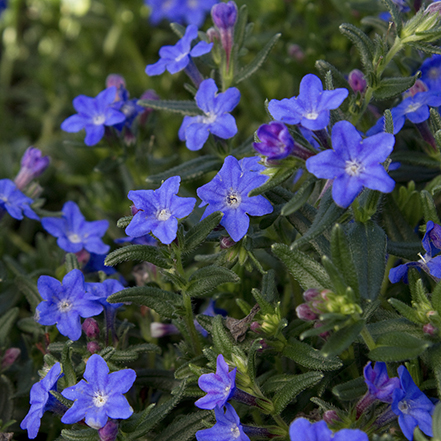
Grace Ward
Lithodora
Deep-blue flowers cover this wonderful sprawling groundcover and attract butterflies. The slightly mounded form adds softness and color to the top of retaining walls and container edges. Performs best with some shade in extremely hot areas. Partial to full sun. Up to 1' tall, slowly spreads up to 4 ft. wide. Zones 6-9.
Phenomenal
French Lavender
Fragrant mounds of silver foliage bloom with purple-blue flower spikes. This cold-hardy lavender does not die back in the winter like other varieties and is notable for its disease resistance and heat and humidity tolerance. Full sun. Up to 4' tall and wide. Zones 4-8.
Harlequin™ Purple
Beardtongue
Long-blooming, showy, plentiful spikes of large purple flowers are a valuable source of nectar for bees, butterflies, and hummingbirds. The compact habit makes this a great plant for perennial borders, rock gardens, and containers. Full sun. Up to 22" tall, 16" wide. Zones 5-9.
Dark Matter™
Meadow Sage
Beautiful, dark-purple flower spikes start blooming early and rebloom throughout the summer. Bees, butterflies, and hummingbirds are drawn to the vivid purple flowers. A great low-maintenance addition to pollinator gardens. Full sun. Up to 16" tall, 12" wide. Zones 4-9.
Pollinator Garden Style: Curated Color (Landscape Plan)
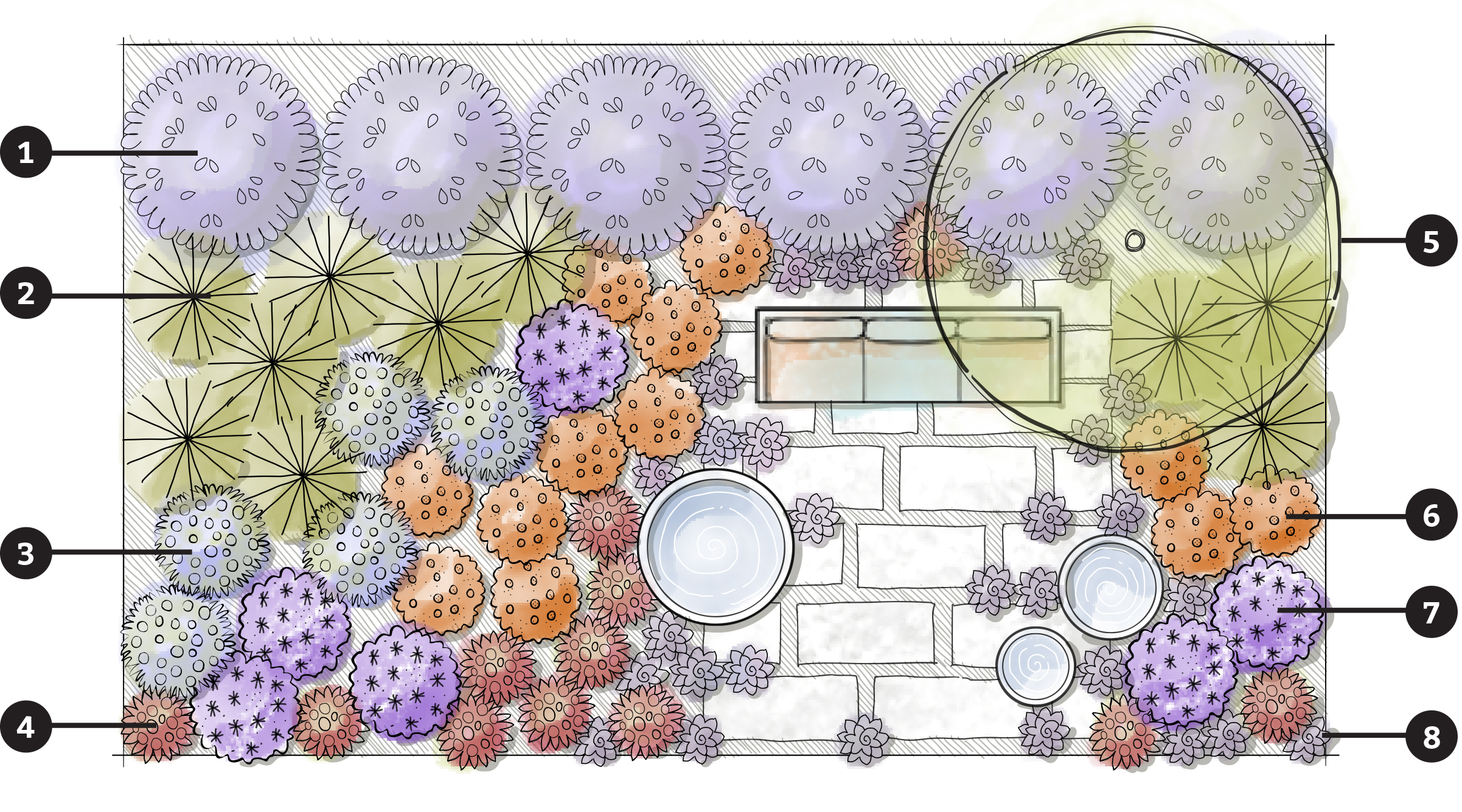
If you love big bursts of color balanced with an element of sophistication and elegance, the curated color pollinator garden style is for you. A pared-down yet bright color palette brings a sense of liveliness and joy to the outdoor space, while a thoughtful layout and well-organized planting plan lend an elevated aesthetic. This garden style demonstrates a sense of intentional design, where every element is curated to create a harmonious and balanced composition.
The combination of clean lines, massed plants, and well-structured hardscapes creates a visually pleasing and timeless look that appeals to those who appreciate style and sophistication, and enjoy the bright colors of pollinator-friendly blooms. Find five tips for creating your classy, colorful garden below.
5 Tips for Creating a Curated and Colorful Pollinator Garden
1. Make a list of your favorite colors, and then choose 2-3 for your color palette. Landscape architect Lisa Nunamaker says "I encourage my students to have no more than 3 colors in their palette. Each outdoor room can have a different palette but try to narrow it down to a few colors. It really unifies the design when you can do that." See more of Lisa's design advice here and find her landscape plans in our digital planning guides.
2. Anchor the planting with a small, flowering tree or shrub. Flowering trees and shrubs are a must for a garden that offers year-round interest. Spring-blooming trees like crabapple, plum, and cherry offer an abundant source of pollen and nectar for pollinators as they emerge in early spring.
2. Create a seating area. To really enjoy a beautiful pollinator garden, you need to be able to slow down and get comfortable. Whether it's a cozy hammock, single garden bench, or a full outdoor living room, make sure you have a space where you can sit comfortably and watch the bees, butterflies, and hummingbirds visiting your garden.
3. Stick to a simple material palette, as well. This approach will create a more soothing feel. Just like choosing no more than 3 colors for your plant palette, choosing a simple material palette keeps your design streamlined and elegant.
4. Pay attention to the transitions. Use soft-textured, low-growing plants to soften the transition from hardscaped pathways or patios in the landscape to the rest of the backyard. Low-growing sedum, creeping thyme, creeping phlox, and ajuga are all great pollinator-friendly groundcovers to use in transitional spaces.
8 pollinator-friendly plants to get this look
1. Petite Indigo® Butterfly Bush
A spectacular summer show of slender, dark lavender to reddish-purple flower spikes accented by gray-green foliage. A useful dwarf form with nectar-rich flowers that have a light, pleasant fragrance. Partial to full sun. Up to 5' tall and wide. Zones 5-9.
2. Northwind Switchgrass
A compact, clumping grass with excellent vertical form. Olive to blue-green foliage turns golden yellow in autumn. Airy flower panicles produce showy seed heads, and sturdy stems stay upright, giving protection to wintering songbirds. Partial to full sun. Up to 6' tall, 3' wide. Zones 4-9.
3. La Barbe Bleue™ Bluebeard
A neat, compact bluebeard with unique, fragrant, and shiny yellow foliage that adds a warm glow to the landscape. An abundance of deep-blue flower spikes offers nectar and pollen in summer and early fall. Full sun. Up to 36" tall, 30" wide. Zones 5-9.
4. Mariachi™ Bandera Helenium
Vibrant flowers on upright stems wave enthusiastically above a compact mound of green foliage. A profusion of gold-tipped, brick-red flowers full of pollen for bees from late summer into fall, often until the first frost. Full sun. Up to 15" tall, 18" wide. Zones 3-9.
5. Prairifire Crabapple
An outstanding early flowering tree with an upright form that becomes rounded with age. Reddish new foliage matures to dark green. Lovely deep pink spring flowers produce persistent, small, dark red-purple fruit. Full sun. Up to 20' tall and wide. Zones 4-8.
6. Gay Butterflies Milkweed
A brilliantly colored, easy-care, and well-behaved milkweed with fiery shades of red, orange, and yellow in summer. Tolerant of lean, unimproved soils, and perfect for naturalized areas, meadows, and borders. Full sun. Up to 3' tall, 2' wide. Zones 4-11.
7. Grape Crush New England Aster
Deep purple flowers are densely packed on a nicely rounded mound. A fantastic way to keep your garden blooming beyond summer, providing continuing bright color and a nectar source for butterflies. Full sun. Up to 2' tall, 3' wide. Zones 3-8.
8. SunSparkler® Firecracker Sedum
Brilliant burgundy-red sedum clusters all season long with soft pink flowers in late summer. Perfect in shallow containers, in front of taller plants, or tucked into pathways. Full sun. Up to 8" tall and wide. Zones 4-10.
More Ideas and Information About Pollinator-Friendly Gardening
- Take a look at the pollinator section of the blog for a variety of stories about pollinator-friendly gardening
- Free Backyard Habitat Guide with Landscape Plans
- Colorful Pollinator Container Garden Ideas
- Easy Pollinator Garden Ideas
- Modern Meadow: A fresh take on pollinator garden design
- What to Plant to Attract Butterflies, Hummingbirds, and Bees
- Ask an Expert: Best Pollinator Plants for the Garden
- Beneficial Insects for a Healthy Garden: A Visual Guide
- Best Early-Spring Flowering Plants to Attract Pollinators
- 10 Early-Blooming, Cold-Hardy Plants for Pollinators
- Late Summer and Fall-Blooming Perennials
- Grow a Pollinator Border
- Sign up for our Grow Beautifully newsletter. You'll get more design inspiration, garden tips, how-tos, and first access to exclusive guides, webinars, and plants.




